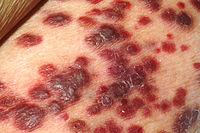
Photo from wikipedia
Equine herpesvirus type 1 (EHV-1) is a highly transmissible pathogen that leads to a variety of clinical disease outcomes in infected horses. A major sequela that can occur after an… Click to show full abstract
Equine herpesvirus type 1 (EHV-1) is a highly transmissible pathogen that leads to a variety of clinical disease outcomes in infected horses. A major sequela that can occur after an EHV-1 infection is a neurological disease termed equine herpesvirus myeloencephalopathy (EHM). Clinical manifestations of EHM include fever, ataxia, incontinence, and partial to full paralysis, which may ultimately lead to the euthanization of the infected horse. To develop an effective treatment strategy for EHM, it is critical that the specific virus–host interactions that lead to EHM be investigated so that safe and effective therapeutic interventions can be developed and delivered. In this study, we examined the ability of four non-steroidal anti-inflammatory drugs (NSAIDs), a steroidal anti-inflammatory drug (dexamethasone), a Rho-kinase (ROCK) inhibitor, and a JAK/STAT inhibitor (AG490) to reduce EHV-1 virus yields and cell-to-cell spread. We show that the NSAID, flunixin meglumine (FM), and the JAK/STAT inhibitor, AG490, significantly reduced virus yields in endothelial and epithelial cell lines, and this inhibition was similar for two neurologic and two non-neurologic EHV-1 strains. In addition to reducing virus yields, AG490 and FM also significantly reduced the ability of EHV-1 to spread laterally from cell to cell.
Journal Title: Frontiers in Veterinary Science
Year Published: 2023
Link to full text (if available)
Share on Social Media: Sign Up to like & get
recommendations!